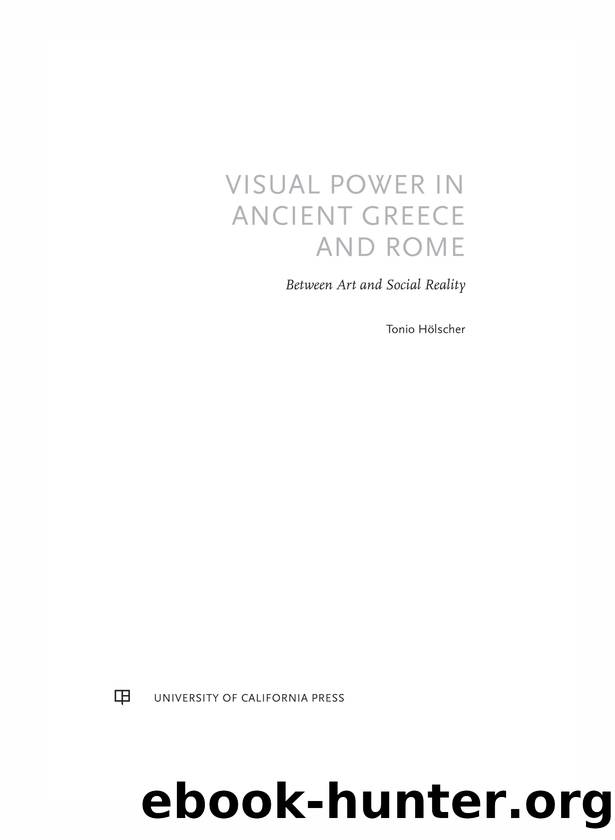Visual Power in Ancient Greece and Rome by Hölscher Tonio;

Author:Hölscher, Tonio;
Language: eng
Format: epub
Publisher: University of California Press
ANALOGOUS AND CONVENTIONAL SIGNS
Language is a medium of conventional signs: The words hÃppos, equus, horse, cheval, and Pferd are totally different designations of the same object; they have no intrinsic, natural connection with the animal that they designate but are sounds that are conventionally assigned to the notion of it. By contrast, the image of a horse has essential traits in common with a real horse: it is to some degree analogous to the object it represents. Art theory is, to be sure, fully aware of this fact but nevertheless often emphasizes instead the fundamental divide between image and reality: the catchword is âaesthetic difference.â7
Indeed, a painted horse on an Archaic Greek vase differs substantially from a real horse in that it is immobile, flat, and bodiless; consists of a shining surface of black glaze; is articulated by linear incisions; and has a regularly stylized mane of parallel waves turned backward. These are conventions of technique and style, which we see as a realm of cultural creativity, transcending the constraints of pregiven reality. It is from such âproductiveâ cultural devices that we derive our understanding of the Greek concept of the horse in its various aspects. This conventionality, however, is not infinite: one can depict a horse through very different conventional designs, but not by a blue circle. No convention could define a blue circle as an image of a horse because of the lack of common essential traits. This does not mean to deny the creative artificiality of images, but to Greek viewers the coincident traits between the real and the depicted horse were quite definitely essential. Therefore, if modern scholarship focuses in particular on the âaesthetic differenceâ between art and reality, this springs from our own perspective; for antiquity we should develop a theoretical approach that not only includes but focuses on the nonconventional, reproductive aspects of figural art.
A specific aspect of the difference between language and image is the fact that language organizes the world into discrete units, words, whereas figural art is a medium of intermediates. Images imitate to some degree the visual worldâs infinitely varied appearances of beings, things, actions, and their multiple, complex cultural significances. Language can designate a âhorseâ or a âhouse,â but images can depict innumerable forms of horses and houses. Language can define qualities, like âbigâ and âsmall,â âbrownâ and âblack,â âstandingâ and ârunning,â with some intermediate or additional stages, but images dispose of an infinite spectrum of forms and sizes, colors and movements. Finally, language indicates inherent values of persons and actions by fixed terms like âdignityâ and âvulgarity,â âheroismâ and âcowardice,â âbeautyâ and âugliness,â whereas images display an immense variety of forms that can be interpreted in various ways in terms of such qualifications. The relevance of these distinctions becomes evident in verbal transcriptions of the ideological programs of Roman state monuments in which the complexity of these concepts is poorly reduced to mere political catchwords.8
Semiotic theory has establishedâin part in the wake of Erwin Panofskyâs iconologyâa model of
Download
This site does not store any files on its server. We only index and link to content provided by other sites. Please contact the content providers to delete copyright contents if any and email us, we'll remove relevant links or contents immediately.
| Africa | Americas |
| Arctic & Antarctica | Asia |
| Australia & Oceania | Europe |
| Middle East | Russia |
| United States | World |
| Ancient Civilizations | Military |
| Historical Study & Educational Resources |
The Daily Stoic by Holiday Ryan & Hanselman Stephen(2712)
The Fate of Rome: Climate, Disease, and the End of an Empire (The Princeton History of the Ancient World) by Kyle Harper(2442)
People of the Earth: An Introduction to World Prehistory by Dr. Brian Fagan & Nadia Durrani(2351)
Ancient Worlds by Michael Scott(2107)
Babylon's Ark by Lawrence Anthony(2073)
Foreign Devils on the Silk Road: The Search for the Lost Treasures of Central Asia by Peter Hopkirk(2059)
India's Ancient Past by R.S. Sharma(1988)
MOSES THE EGYPTIAN by Jan Assmann(1977)
The Complete Dead Sea Scrolls in English (7th Edition) (Penguin Classics) by Geza Vermes(1845)
Lost Technologies of Ancient Egypt by Christopher Dunn(1803)
The Daily Stoic by Ryan Holiday & Stephen Hanselman(1779)
The Earth Chronicles Handbook by Zecharia Sitchin(1754)
24 Hours in Ancient Rome by Philip Matyszak(1684)
Alexander the Great by Philip Freeman(1656)
Aztec by Gary Jennings(1550)
The Nine Waves of Creation by Carl Johan Calleman(1523)
Curse Tablets and Binding Spells from the Ancient World by Gager John G.;(1514)
Before Atlantis by Frank Joseph(1487)
Earthmare: The Lost Book of Wars by Cergat(1472)
